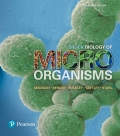
Brock Biology of Microorganisms
15th Edition
ISBN: 9780134626352
Author: MADIGAN
Publisher: PEARSON
expand_more
expand_more
format_list_bulleted
Concept explainers
Question
Chapter 23.1, Problem 1CR
Summary Introduction
Lichens are the symbiotic association that is formed between the
Expert Solution & Answer
Want to see the full answer?
Check out a sample textbook solution
Students have asked these similar questions
Describe two symbiotic relationships between a fungus andanother organism. In each case, explain how each partnerin these associations is affected.
Explain the composition of lichens and why this composition is usually considered a mutualistic relationship.
Explain how the type of nutrition required by fungal cellsdiffers from that required by algae or amoeboids.
Chapter 23 Solutions
Brock Biology of Microorganisms
Ch. 23.1 - What two microbes form a partnership in the lichen...Ch. 23.1 - Prob. 2MQCh. 23.1 - Prob. 1CRCh. 23.2 - What is the evidence that "Chlorochromatium...Ch. 23.2 - Prob. 2MQCh. 23.2 - How might nutrients be shuttled between phototroph...Ch. 23.2 - QWhat mechanisms do the consortia use to orient at...Ch. 23.3 - Prob. 1MQCh. 23.3 - Prob. 2MQCh. 23.3 - What is a bacteroid and what occurs within it?...
Ch. 23.3 - What are the major similarities and differences...Ch. 23.3 - QDescribe the steps in the development of root...Ch. 23.4 - Prob. 1MQCh. 23.4 - Prob. 2MQCh. 23.4 - How do mycorrhizal fungi promote plant diversity?Ch. 23.4 - Prob. 1CRCh. 23.5 - Prob. 1MQCh. 23.5 - How do the vir genes differ from T-DNA in the Ti...Ch. 23.5 - How has an understanding of crown gall disease...Ch. 23.5 - Prob. 1CRCh. 23.6 - Prob. 1MQCh. 23.6 - What are the consequences of symbiont genome...Ch. 23.6 - How could it be determined if a symbiont and its...Ch. 23.6 - QHow is it possible for aphids to feed only on the...Ch. 23.7 - How are anoxic conditions maintained in the...Ch. 23.7 - Why does reductive acetogenesis predominate over...Ch. 23.7 - Prob. 3MQCh. 23.7 - QHow do the microbial communities of higher and...Ch. 23.8 - Prob. 1MQCh. 23.8 - Prob. 2MQCh. 23.8 - How is the correct bacterial symbiont selected in...Ch. 23.9 - Prob. 1MQCh. 23.9 - What are the similarities of the obligate...Ch. 23.9 - Prob. 3MQCh. 23.9 - Prob. 1CRCh. 23.10 - What evidence suggest that the nematodes and their...Ch. 23.10 - What prevents other bacteria from colonizing the...Ch. 23.10 - QWhy are entomopathogenic nematodes so attractive...Ch. 23.11 - Prob. 1MQCh. 23.11 - What are the two mechanisms of Symbiodinium...Ch. 23.11 - Prob. 3MQCh. 23.11 - Prob. 1CRCh. 23.12 - Prob. 1MQCh. 23.12 - Prob. 2MQCh. 23.12 - Prob. 1CRCh. 23.13 - Prob. 1MQCh. 23.13 - Prob. 2MQCh. 23.13 - Prob. 3MQCh. 23.13 - QGive an example of a single microbial species...Ch. 23 - Imagine that you have discovered a new animal that...Ch. 23 - Prob. 2AQ
Knowledge Booster
Learn more about
Need a deep-dive on the concept behind this application? Look no further. Learn more about this topic, biology and related others by exploring similar questions and additional content below.Similar questions
- Which parasitic protist evades the host immune system by altering its surface proteins with each generation? a. Paramecium caudatum b. Trypanosoma brucci c. Plasmodium falciparum d. Phytophthora infrstansarrow_forwardExplain how the definition of protists ensures that the kingdom Protista includes a wide diversity of cellular structures. Provide an example of two different structures that perform the same function for their respective protist.arrow_forwardWhat term describes the close association of a fungus with the root of a tree? a. arhizoid b. a lichen c. a mycorrhiza d. anendophytearrow_forward
- Justify (a) classifying fungi as opisthokonts, (b) classifying microsporidia as fungi, and (c) grouping ascomycetes and basidiomycetes as sister cladesarrow_forwarda. Describe the bacteria in the actinomycete group, and explain whatcharacteristics make them similar to fungi.b. Briefly describe two of the common diseases caused by this group.arrow_forwardlichens are considered good examples of obligate mutualisms.Comment?arrow_forward
arrow_back_ios
SEE MORE QUESTIONS
arrow_forward_ios
Recommended textbooks for you
 Concepts of BiologyBiologyISBN:9781938168116Author:Samantha Fowler, Rebecca Roush, James WisePublisher:OpenStax College
Concepts of BiologyBiologyISBN:9781938168116Author:Samantha Fowler, Rebecca Roush, James WisePublisher:OpenStax College Biology 2eBiologyISBN:9781947172517Author:Matthew Douglas, Jung Choi, Mary Ann ClarkPublisher:OpenStax
Biology 2eBiologyISBN:9781947172517Author:Matthew Douglas, Jung Choi, Mary Ann ClarkPublisher:OpenStax

Concepts of Biology
Biology
ISBN:9781938168116
Author:Samantha Fowler, Rebecca Roush, James Wise
Publisher:OpenStax College

Biology 2e
Biology
ISBN:9781947172517
Author:Matthew Douglas, Jung Choi, Mary Ann Clark
Publisher:OpenStax
12DaysinMarch, Genital Infections for USMLE Step One; Author: Howard Sachs;https://www.youtube.com/watch?v=66zR_FypVFQ;License: Standard youtube license